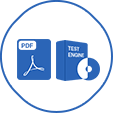Last Update 14 hours ago Total Questions : 373
The Commercial Negotiation content is now fully updated, with all current exam questions added 14 hours ago. Deciding to include L4M5 practice exam questions in your study plan goes far beyond basic test preparation.
You'll find that our L4M5 exam questions frequently feature detailed scenarios and practical problem-solving exercises that directly mirror industry challenges. Engaging with these L4M5 sample sets allows you to effectively manage your time and pace yourself, giving you the ability to finish any Commercial Negotiation practice test comfortably within the allotted time.
Lina Rawlins is a senior buyer working for a medical equipment company. Lina is in charge of the company’s largest supplier account, Great Barrington Gas (GBG), a medical equipment supplier. Recently GBG’s performance has declined, which has led to an increasing number of rejected items. Lina is aware of the seriousness of this, given the nature of the item, and has asked GBG to attend an urgent meeting. In the meeting, Lina asked the GBG representative “Can you tell me exactly what you are doing to ensure quality?” What type of question is Lina asking?
Which of the following should be done when undertaking a reflection activity on negotiation? Select TWO that apply.
Which of the following would be considered appropriate influencing techniques in contract negotiation? Select TWO that apply.
A competitive win-lose distributive approach to a negotiation is seeking to:
A skilled negotiator will use a range of questioning techniques in a negotiation. If they wished to explore options with the other party without making any formal commitment, which type of question style would they use?
An organization should develop different relationships which are appropriate to each supplier situation. Which ONE of the following analysis methods could help to identify these?
A supplier can produce a product for $160. The supplier sells the product to their client for $240, making a profit before tax of $80 on the transaction.
What is the mark-up profit percentage earned by the supplier on this transaction?

